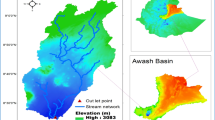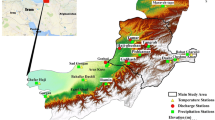Abstract
Climatic changes have a significant impact on the hydrologic behavior of a river especially its discharge. Sustainable management of water resources necessitates an examination of spatiotemporal variation in climatic parameters such as precipitation and temperature to quantify their relationships with the river discharge. The present study develops both parametric and non-parametric models by modifying the tools of ‘R’ statistical software (version 3.2.2) to investigate variations in 11 climatic parameters for a 117-year dataset (1900–2017) in Ganges River basin of India. The novelty of the modified hydroclimatic spatiotemporal trend model is its ability to explore seasonal trends and Sen’s slopes of climatic parameters while avoiding trend-autocorrelation complications using an advanced Mann–Kendall test and Sen’s slope estimator. Furthermore, relationships among the Sen’s slopes of each climatic parameter are assessed to investigate the trend interdependencies. Parametric modeling has been performed to develop relationships among precipitation and remaining climatic parameters. Model validation results suggest non-parametric model to quantify relationships between precipitation and river discharge for a long-term data series. The results demonstrate that the forecasted precipitation exhibits a gradually decreasing trend leading to a significantly decreasing trend in river discharge (15–21%) for the next three decades (2030, 2040 and 2050). The model outcomes guide the water managers towards framing sustainable policies for managing water supplies, floods and droughts, hydropower development, barrage operation control, and environmental flows.








Similar content being viewed by others
References
Abdi A, Hassanzadeh Y, Talatahari S et al (2016) Regional bivariate modeling of droughts using L-comoments and copulas. Stoch Environ Res Risk Assess 31(5):1199–1210
Azmat M, Liaqat UW, Qamar MU, Awan UK (2017) Impacts of changing climate and snow cover on the flow regime of Jhelum River, Western Himalayas. Reg Environ Change 17(3):813–825
Bates BC, Kundzewicz Z, Wu S, Palutikof J (2008) Climate change and water, technical paper of the intergovernmental panel on climate change. IPCC Secretariat, Geneva, 3–4
Biao EI (2017) Assessing the impacts of climate change on river discharge dynamics in Oueme River Basin (Benin, West Africa). Hydrology 4(4):1–16
Chandler RE, Scott ME (2011) Statistical methods for trend detection and analysis in the environmental analysis. Wiley, Chichester
Charlton MB, Arnell NW (2014) Assessing the impacts of climate change on river flows in England using the UKCP09 climate change projections. J Hydrol 519(Part B):1723–1738
Coscarelli R, Caloiero T (2012) Analysis of daily and monthly rainfall concentration in Southern Italy (Calabria region). J Hydrol 416:145–156
Coulthard TJ, Lewin J, Macklin MG (2005) Modelling differential catchment response to environmental change. Geomorphology 69(1–4):222–241
Croitoru AE, Minea I (2015) The impact of climate changes on rivers discharge. Theor Appl Climatol 120(3):563–573
CWC (2016) Annual report. Ministry of Water Resources, River Development & Ganga Rejuvenation, Central Water Commission (CWC), New Delhi, India
Guo J, Huang G, Wang X, Li Y, Yang L (2018) Future changes in precipitation extremes over China projected by a regional climate model ensemble. Atmos Environ 188:142–156
Hirsch RM, Archfield SA, Cicco LAD (2015) A bootstrap method for estimating uncertainty of water quality trends. Environ Model Softw 73:148–166. https://doi.org/10.1016/j.envsoft.2015.07.017
IMD (2013) State level climate change trends in India. Indian Metrological Department, New Delhi
Jeuland M, Harshadeep N, Escurra J et al (2013) Implications of climate change for water resources development in the Ganges basin. Water Policy 15:26–50
Kendall MG (1962) Rank correlation methods. J Am Stat Assoc 63(324):1379–1389. https://doi.org/10.1080/01621459.1968.10480934
Khalili K, Tahoudi MN, Mirabbasi R, Ahmadi F (2016) Investigation of spatial and temporal variability of precipitation in Iran over the last half century. Stoch Environ Res Risk Assess 30(4):1205–1221
Kundzewicz ZW, Kanae S, Seneviratne SI et al (2014) Flood risk and climate change: global and regional perspectives. Hydrol Sci J 59(1):1–28
Li Z, Huang G, Wang X, Han J, Fan Y (2016) Impacts of future climate change on river discharge based on hydrological inference: a case study of the Grand River Watershed in Ontario, Canada. Sci Total Environ 548–549:198–210
Maccioni P, Kossida M, Brocca L, Moramarco T (2015) Assessment of the drought hazard in the Tiber River Basin in Central Italy and a comparison of new and commonly used meteorological indicators. J Hydrol Eng 20(8):05014029
Mann HB (1945) Nonparametric tests against trend. Econometrica 13(3):245–259
MoEF (2017) Annual Report. Ministry of Environment, Forests (MoEF) and Climate Change, Government of India, New Delhi, India
MoWR (2017) Annual Report. Ministry of Water Resources (MoWR), River Development and Ganga rejuvenation, Ganga basin, Government of India, New Delhi, India
Mutenyo I, Nejadhashemi AP, Woznicki SA, Giri S (2013) Evaluation of swat performance on a mountainous watershed in Tropical Africa. Hydrol Current Res S 14:001. https://doi.org/10.4172/2157-7587.S14-001
Nash JE, Sutcliffe JV (1970) River flow forecasting through conceptual models. 1: Discussion of principles. J Hydrol 10(3):282–290
Nijssen B, O’Donnell G, Hamlet AF, Lettenmaier DP (2001) Hydrologic sensitivity of global rivers to climate change. Clim Change 50:143–175
Radinović D, Ćurić M (2012) Some evidence on European monsoon existence. Theor Appl Climatol 110(1–2):11–15. https://doi.org/10.1007/s00704-012-0609-y
Sansigolo CA, Kayano MT (2010) Trends of seasonal maximum and minimum temperatures and precipitation in Southern Brazil for the 1913–2006 period. Theoret Appl Climatol 101(1):209–216
Sen PK (1968) Estimates of the regression coefficient based on Kendall’s Tau. J Am Stat Assoc 63(324):1379–1389
Shafaie M et al (2016) Modeling flood event characteristics using D-vine structures. Theor Appl Climatol 130(3–4):713–724
Shen M, Chen J, Zhuan H et al (2017) Estimating uncertainty and its temporal variation related to global climate models in quantifying climate change impacts on hydrology. J Hydrol 556:10–24. https://doi.org/10.1016/j.jhydrol.2017.11.004
Singh AP, Ghosh SK (2003a) Uncertainty analysis in river basin water quality management. In: Raju KS, Sarkar AK, Dash ML (eds) Integrated water resources planning and management. Jain Brothers, New Delhi, pp 260–268
Singh AP, Ghosh SK (2003b) Conceptual modeling and management of water quality in a River Basin. Recent trends in hydrogeochemistry. Capital Books, New Delhi, pp 207–220
Singh AP, Ghosh SK, Sharma P (2007) Water quality management of a stretch of river Yamuna: an interactive fuzzy multi-objective approach. Water Resour Manag 21(2):515–532
Singh AP, Dhadse K, Ahalawat J (2019) Managing water quality of a river using an integrated geographically weighted regression technique with fuzzy decision making model. Environ Monit Assess 191(6):378. https://doi.org/10.1007/s10661-019-7487-z
Srinivas R, Singh AP, Sharma R (2017) A scenario-based impact assessment of trace metals on ecosystem of river Ganges using multivariate analysis coupled with fuzzy decision-making approach. Water Resour Manag 31(13):4165–4185
Srinivas R, Singh AP, Dhadse K, Garg C, Deshmukh A (2018) Sustainable management of a river basin by integrating an improved fuzzy based hybridized SWOT model and geo-statistical weighted thematic overlay analysis. J Hydrol 563:92–105
Tabari H, Talaee PH (2011) Temporal variability of precipitation over Iran: 1966–2005. J Hydrol 396(3):313–320
Tripathi A, Kumar N, Chauhan DK (2017) Understanding integrated impacts of climate change and pollution on ganges river system: a mini review on biological effects, knowledge gaps and research needs. SM J Biol 3(1):1017
United States Geological Survey-USGS (2012) Simulation of daily streamflows at gaged and ungaged locations within the Cedar River Basin, Iowa, using a precipitation-runoff modeling system model. Scientific investigations report 2012–5213
Vliet MTHV, Yearsley JR, Franssen WHP et al (2012) Coupled daily streamflow and water temperature modelling in large river basins. Hydrol Earth Syst Sci 16:4303–4321
Wang Q, Wu X, Zhao B et al (2015) Combined multivariate statistical techniques, Water Pollution Index (WPI) and daniel trend test methods to evaluate temporal and spatial variations and trends of water quality at Shanchong river in the Northwest Basin of Lake Fuxian, China. PLoS ONE 10(4):1–17
Wen G, Huang G, Hu K et al (2014) Changes in the characteristics of precipitation over northern Eurasia. Theor Appl Climatol 119(3–4):653–665
Whitehead PG, Barbour E, Futter MN et al (2015) Impacts of climate change and socio-economic scenarios on flow and water quality of the Ganges, Brahmaputra and Meghna (GBM) river systems: low flow and flood statistics. Process and Impacts, Environmental Science. https://doi.org/10.1039/c4em00619d
Xu H, Luo Y (2015) Climate change and its impacts on river discharge in two climate regions in China. Hydrol Earth Syst Sci 19:4609–4618
Xu H, Taylor RG, Xu Y (2011) Quantifying uncertainty in the impacts of climate change on river discharge in sub-catchments of the Yangtze and Yellow River Basins, China. Hydrol Earth Syst Sci 15:333–344
Ye B, Yang D, Kane DL (2003) Changes in Lena River streamflow hydrology: human impacts versus natural variations. Water Resour Res 39(7):1200
Zamani R, Mirabbasi R, Nazeri M et al (2018) Spatio-temporal analysis of daily, seasonal and annual precipitation concentration in Jharkhand state, India. Stoch Environ Res Risk Assess 32:1085–1097
Zeynoddin M, Bonakdari H, Azari A, Ebtehaj I et al (2018) Novel hybrid linear stochastic with non-linear extreme learning machine methods for forecasting monthly rainfall a tropical climate. J Environ Manag 222:190–206
Zhang JY, Huang GR, Wang ZJ et al (2011) Analysis of temporal and spatial variation of rainfall in Guangzhou City at recent years. Water Resour Power 29:5
Author information
Authors and Affiliations
Corresponding author
Additional information
Publisher's Note
Springer Nature remains neutral with regard to jurisdictional claims in published maps and institutional affiliations.
Electronic supplementary material
Below is the link to the electronic supplementary material.
Rights and permissions
About this article
Cite this article
Srinivas, R., Singh, A.P., Dhadse, K. et al. Hydroclimatic river discharge and seasonal trends assessment model using an advanced spatio-temporal model. Stoch Environ Res Risk Assess 34, 381–396 (2020). https://doi.org/10.1007/s00477-020-01780-6
Published:
Issue Date:
DOI: https://doi.org/10.1007/s00477-020-01780-6




